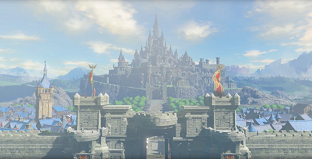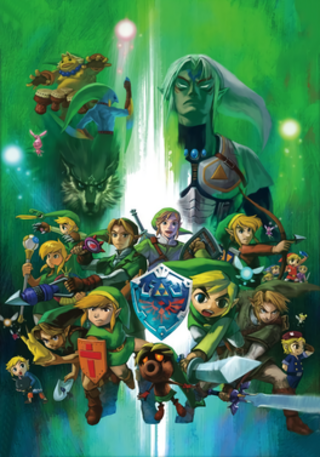TimeSplitters is a video game series.
TimeSplitters may also refer to:
- TimeSplitters (video game), a 2000 video game, first in the series
- Time Splitters (professional wrestling), tag team active from 2012 to 2015
TimeSplitters is a video game series.
TimeSplitters may also refer to:

The Legend of Zelda is an action-adventure game franchise created by the Japanese game designers Shigeru Miyamoto and Takashi Tezuka. It is primarily developed and published by Nintendo, although some portable installments and re-releases have been outsourced to Capcom, Vanpool, and Grezzo. The gameplay incorporates action-adventure and elements of action RPG games.

The Legend of Zelda is a video game franchise created by Japanese video game designers Shigeru Miyamoto and Takashi Tezuka. It is mainly developed and published by Nintendo. The universe of the Legend of Zelda series consists of a variety of lands, the most predominant being Hyrule. The franchise is set within a fantasy world that is reminiscent of medieval Europe and consists of several recurring locations, races and creatures. The most prominent population in the series are the Hylians, a humanoid race with elfin features, that are identifiable by their long, pointed ears. The game world is accompanied by a detailed fictional lore that contains a creation myth, several constructed languages, the most prominent being Hylian, and a fictional universal currency called the rupee. Most games in The Legend of Zelda series follow a similar storyline, which involves the protagonist Link battling monsters to save Princess Zelda and defeat an evil villain, which is often the series' main antagonist, Ganon. Nintendo developed the fictional lore into a complex timeline that spans across the series and chronicles thousands of years of fictional history.

Shigeru Miyamoto is a Japanese video game designer, producer and game director at Nintendo, where he serves as one of its representative directors. Widely regarded as one of the most accomplished and influential designers in the history of video games, he is the creator of some of the most acclaimed and best-selling game franchises of all time, including Mario,The Legend of Zelda, Donkey Kong, Star Fox and Pikmin.

The Legend of Zelda: Ocarina of Time is an action-adventure game developed and published by Nintendo for the Nintendo 64. It was released in Japan and North America in November 1998, and in PAL regions the following month. Ocarina of Time is the first game in The Legend of Zelda series with 3D graphics.
A multiplayer video game is a video game in which more than one person can play in the same game environment at the same time, either locally on the same computing system, on different computing systems via a local area network, or via a wide area network, most commonly the Internet. Multiplayer games usually require players to share a single game system or use networking technology to play together over a greater distance; players may compete against one or more human contestants, work cooperatively with a human partner to achieve a common goal, or supervise other players' activity. Due to multiplayer games allowing players to interact with other individuals, they provide an element of social communication absent from single-player games.

The Triforce is a fictional artifact and icon of Nintendo's The Legend of Zelda series of video games. It first appeared in the original 1986 action-adventure game The Legend of Zelda and is a focus of subsequent games in the series, including The Adventure of Link, A Link to the Past, Ocarina of Time, Oracle of Ages, Oracle of Seasons, The Wind Waker, Skyward Sword, and A Link Between Worlds. The Triforce consists of three equilateral triangles, which are joined to form a large equilateral triangle. In the lore of the series, it represents the essence of the Golden Goddesses who create the realm of Hyrule and is able to grant godlike power to the character who holds all three pieces. The Triforce also represents the three main characters of the series, Ganon, Zelda and Link, and their inherent qualities in the battle between good and evil. Due to its prominence and significance within the mythology of the Zelda series, the Triforce has received positive comments for being a widely recognisable symbol in gaming.

Link is the protagonist of Nintendo's video game franchise The Legend of Zelda. He was created by Japanese video game designer Shigeru Miyamoto. Link was introduced as the hero of the original 1986 The Legend of Zelda video game and has appeared in a total of 19 entries in the series, as well as a number of spin-offs. Common elements in the series include Link travelling through Hyrule whilst exploring dungeons, battling creatures and solving puzzles until he eventually defeats the series' primary antagonist, Ganon, and saves Princess Zelda.
Diablo or El Diablo may refer to:
TimeSplitters 2 is a first-person shooter video game developed by Free Radical Design and published by Eidos Interactive for PlayStation 2, Xbox and GameCube game consoles. It is the second game in the TimeSplitters series, and a sequel to the original TimeSplitters.
Rhapsody may refer to:
Horde may refer to:

TimeSplitters is a series of first-person shooter video games developed by Free Radical Design. The games are often considered spiritual successors to GoldenEye 007 and Perfect Dark, due to overlapping elements in gameplay, design, and development team. Each game features a time travelling element in which players battle across a diverse number of locations and periods in history.
Split(s) or The Split may refer to:
Half-life is a mathematical and scientific description of exponential or gradual decay.
A video game with nonlinear gameplay presents players with challenges that can be completed in a number of different sequences. Each player may take on only some of the challenges possible, and the same challenges may be played in a different order. Conversely, a video game with linear gameplay will confront a player with a fixed sequence of challenges: every player faces every challenge and has to overcome them in the same order.
Split screen may refer to:
Transformers is a franchise centered on shapeshifting alien robots.

Smosh is an American YouTube sketch comedy-improv collective founded by Anthony Padilla and Ian Hecox. In 2002, Padilla created a website named "smosh.com" for making Flash animations, and he was later joined by Hecox. They began to post videos on Smosh's YouTube channel in the autumn of 2005 and quickly became one of the most popular channels on the site. As of May 2022, the Smosh channel has over 10 billion views and over 25 million subscribers.
Split Second may refer to:
Split personality is a popular term used to refer to the mental illness dissociative identity disorder, which was previously known as multiple personality disorder.